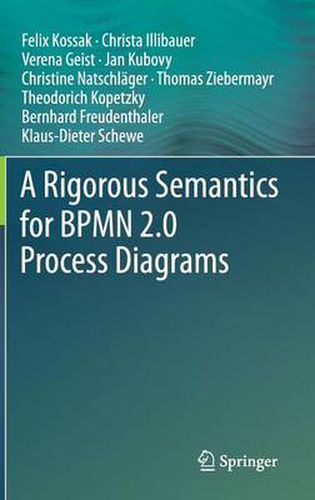Readings Newsletter
Become a Readings Member to make your shopping experience even easier.
Sign in or sign up for free!
You’re not far away from qualifying for FREE standard shipping within Australia
You’ve qualified for FREE standard shipping within Australia
The cart is loading…






This title is printed to order. This book may have been self-published. If so, we cannot guarantee the quality of the content. In the main most books will have gone through the editing process however some may not. We therefore suggest that you be aware of this before ordering this book. If in doubt check either the author or publisher’s details as we are unable to accept any returns unless they are faulty. Please contact us if you have any questions.
This book provides the most complete formal specification of the semantics of the Business Process Model and Notation 2.0 standard (BPMN) available to date, in a style that is easily understandable for a wide range of readers - not only for experts in formal methods, but e.g. also for developers of modeling tools, software architects, or graduate students specializing in business process management.
BPMN - issued by the Object Management Group - is a widely used standard for business process modeling. However, major drawbacks of BPMN include its limited support for organizational modeling, its only implicit expression of modalities, and its lack of integrated user interaction and data modeling. Further, in many cases the syntactical and, in particular, semantic definitions of BPMN are inaccurate, incomplete or inconsistent. The book addresses concrete issues concerning the execution semantics of business processes and provides a formal definition of BPMN process diagrams, which can serve as a sound basis for further extensions, i.e., in the form of horizontal refinements of the core language.
To this end, the Abstract State Machine (ASMs) method is used to formalize the semantics of BPMN. ASMs have demonstrated their value in various domains, e.g. specifying the semantics of programming or modeling languages, verifying the specification of the Java Virtual Machine, or formalizing the ITIL change management process.
This kind of improvement promotes more consistency in the interpretation of comprehensive models, as well as real exchangeability of models between different tools. In the outlook at the end of the book, the authors conclude with proposing extensions that address actor modeling (including an intuitive way to denote permissions and obligations), integration of user-centric views, a refined communication concept, and data integration.
$9.00 standard shipping within Australia
FREE standard shipping within Australia for orders over $100.00
Express & International shipping calculated at checkout
This title is printed to order. This book may have been self-published. If so, we cannot guarantee the quality of the content. In the main most books will have gone through the editing process however some may not. We therefore suggest that you be aware of this before ordering this book. If in doubt check either the author or publisher’s details as we are unable to accept any returns unless they are faulty. Please contact us if you have any questions.
This book provides the most complete formal specification of the semantics of the Business Process Model and Notation 2.0 standard (BPMN) available to date, in a style that is easily understandable for a wide range of readers - not only for experts in formal methods, but e.g. also for developers of modeling tools, software architects, or graduate students specializing in business process management.
BPMN - issued by the Object Management Group - is a widely used standard for business process modeling. However, major drawbacks of BPMN include its limited support for organizational modeling, its only implicit expression of modalities, and its lack of integrated user interaction and data modeling. Further, in many cases the syntactical and, in particular, semantic definitions of BPMN are inaccurate, incomplete or inconsistent. The book addresses concrete issues concerning the execution semantics of business processes and provides a formal definition of BPMN process diagrams, which can serve as a sound basis for further extensions, i.e., in the form of horizontal refinements of the core language.
To this end, the Abstract State Machine (ASMs) method is used to formalize the semantics of BPMN. ASMs have demonstrated their value in various domains, e.g. specifying the semantics of programming or modeling languages, verifying the specification of the Java Virtual Machine, or formalizing the ITIL change management process.
This kind of improvement promotes more consistency in the interpretation of comprehensive models, as well as real exchangeability of models between different tools. In the outlook at the end of the book, the authors conclude with proposing extensions that address actor modeling (including an intuitive way to denote permissions and obligations), integration of user-centric views, a refined communication concept, and data integration.